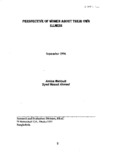| dc.description.abstract | Introduction
In Bangladesh women's health issues are traditionally neglected and inadequate importance is
given by all concerns. A majority of the women experience significant morbidity associated
with pregnancy and delivery (Goodburn et al., 1994). Since women's health is a fundamental
human right and must clearly be promoted as such immediate attention should be given to this
concern (WHO, 1995). With this interest, women's health problem should be recognized and
addressed from their own perspective. Because research results show that women's health
behaviour is governed by what they perceive as good or ill health, whether this is consistent
with bio-medical model or not (Khatib, 1992). So to promote women's health, their health
problems should be addressed from their own perspective.
Objectives
The study aimed to understand illnesses from the perspective of women in the community and
their health seeking behaviour with respect to some specific illness.
Methodology
This qualitative study was exploratory by nature. The cognitive and symbolic aspects were the
main focus in the study. K1~an's concept of 'explanatory model' helped to map out and
interpret the ideas in the study. Being a part of the BRAC-ICDDR,B joint research project the
study was done in Matlab DSS (Demographic Surveillance System) area purposively. The
study population was the married women in the study area (age ranges from 18 to 50). The
study dealt with both BRAC and non BRAC women separately. Simple random sampling
technique and convenient sampling were used to select the informants. Different qualitative
methods were used for data collection, such as- free listing, pile sorting, matrix ranking, key
informant interview and group discussions.
Findings
The study revealed that women had their own definition about ill health condition. They
were also found to link up different illnesses based on their own reasoning. While
determining the severity of a condition immediate threat to life was of prime concern to
them.
The study women had their own perspective in explaining every illness they experienced
and thus they identified the causes of ill health and amplified a pattern of the ailment.
There were certain folk theories such as hot and cold, purity and pollution, batas laga,
110sto kora, etc. by which they constructed the causal relations. In diagnosing ill health,
knowledge about different illnesses (learned from other's experiences) and consultation
with relatives, neighbors or traditional healers were the significant factors.
Therapeutic Choice of the women largely depended on beliefs about the causes of illness,
explanation of illness, availability of health services, socioeconomic condition, and past
experience of efficacy of treatment. It was found that the women did not rely on one
therapeutic method throughout the whole course of illness episode. They tried one by one
accessible medical services and sometimes repeated the earliest one. However, other
pattern of 'illness specific' health seeking behavioural was also observed (Hardon et aL
1995). The women usually termed bhute dhora, alga dhora, etc. as illnesses caused by
evil spirit. In such cases, they seek kabiraji and moulovi treatment. They blindly believed
that only the Allahar kalam (divine verses) could help cure the illness.
Attitude of the society and family towards illness acted as an influencing factor at every
stage from illness identification to treatment seeking behaviour. Women often tried to
conceal some illnesses which have social stigma attached. In such situation women tried
not to disclose the illness to their in-laws and husbands, rather getting treatment
themselves through peer network and as a last resort, went to natal home for treatment.
Conclusion
It was explicit in the study that the identification of the illness and therapeutic choice were
primarily done by the women themselves. Therefore, knowledge about women's
perspective towards the illness and its gravity, is very much crucial. In conclusion, we
would like to make the following recommendations:
• On the basis of this study finding some focused ethnography on particular women's
illnesses can be designed. That will help us to get a detailed picture on different illness
situation specifically. That may provide new insight regarding women's health
intervention issues.
• BRAC could help the destitute women in the village who have been suffering from
different reproductive health problems for a long time but can not seek medical help | en_US |

